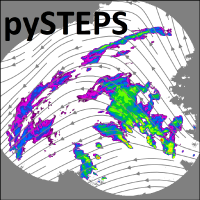pysteps.timeseries.correlation.temporal_autocorrelation#
- pysteps.timeseries.correlation.temporal_autocorrelation(x, d=0, domain='spatial', x_shape=None, mask=None, use_full_fft=False, window='gaussian', window_radius=inf)#
Compute lag-l temporal autocorrelation coefficients \(\gamma_l=\mbox{corr}(x(t),x(t-l))\), \(l=1,2,\dots,n-1\), from a time series \(x_1,x_2,\dots,x_n\). If a multivariate time series is given, each element of \(x_i\) is treated as one sample from the process generating the time series. Use
temporal_autocorrelation_multivariate()if cross-correlations between different elements of the time series are desired.- Parameters:
x (array_like) – Array of shape (n, …), where each row contains one sample from the time series \(x_i\). The inputs are assumed to be in increasing order with respect to time, and the time step is assumed to be regular. All inputs are required to have finite values. The remaining dimensions after the first one are flattened before computing the correlation coefficients.
d ({0,1}) – The order of differencing. If d=1, the input time series is differenced before computing the correlation coefficients. In this case, a time series of length n+1 is needed for computing the n-1 coefficients.
domain ({"spatial", "spectral"}) – The domain of the time series x. If domain is “spectral”, the elements of x are assumed to represent the FFTs of the original elements.
x_shape (tuple) – The shape of the original arrays in the spatial domain before applying the FFT. Required if domain is “spectral”.
mask (array_like) – Optional mask to use for computing the correlation coefficients. Input elements with mask==False are excluded from the computations. The shape of the mask is expected to be x.shape[1:]. Applicable if domain is “spatial”.
use_full_fft (bool) – If True, x represents the full FFTs of the original arrays. Otherwise, the elements of x are assumed to contain only the symmetric part, i.e. in the format returned by numpy.fft.rfft2. Applicable if domain is ‘spectral’. Defaults to False.
window ({"gaussian", "uniform"}) – The weight function to use for the moving window. Applicable if window_radius < np.inf. Defaults to ‘gaussian’.
window_radius (float) – If window_radius < np.inf, the correlation coefficients are computed in a moving window. Defaults to np.inf (i.e. the coefficients are computed over the whole domain). If window is ‘gaussian’, window_radius is the standard deviation of the Gaussian filter. If window is ‘uniform’, the size of the window is 2*window_radius+1.
- Returns:
out – List of length n-1 containing the temporal autocorrelation coefficients \(\gamma_i\) for time lags \(l=1,2,...,n-1\). If window_radius<np.inf, the elements of the list are arrays of shape x.shape[1:]. In this case, nan values are assigned, when the sample size for computing the correlation coefficients is too small.
- Return type:
list
Notes
Computation of correlation coefficients in the spectral domain is currently implemented only for two-dimensional fields.
